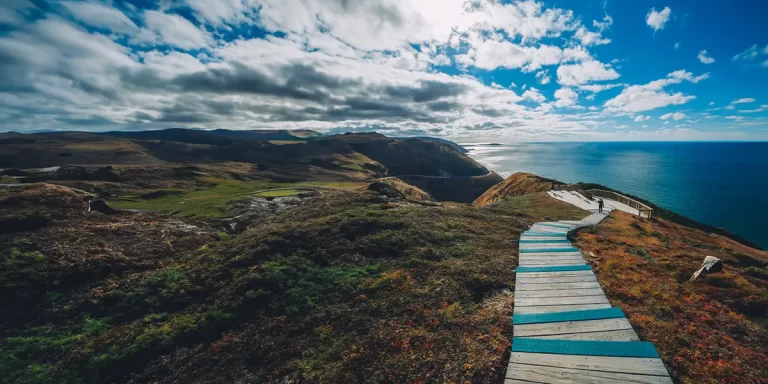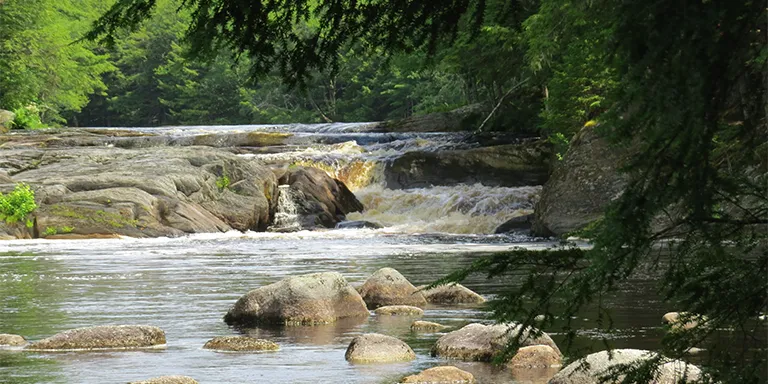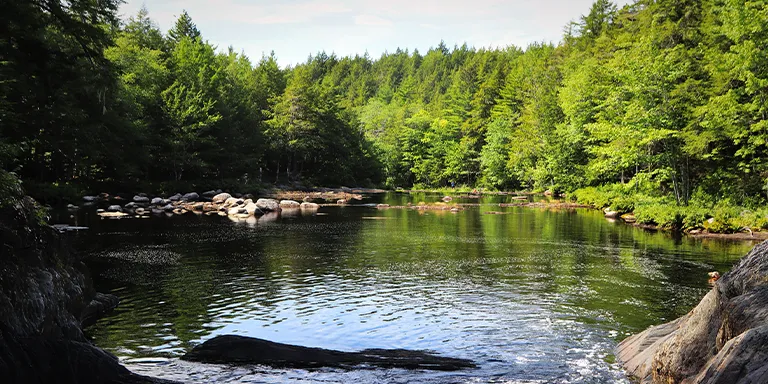

Backpacking in Nova Scotia offers a truly unique and exhilarating experience for outdoor enthusiasts. This maritime province boasts a rugged coastline, dense forests, and highland trails that will leave you in awe of nature’s majesty.
Popular destinations like Cape Breton Highlands National Park, with its world-famous Cabot Trail, and Kejimkujik National Park, renowned for its dark sky preserves, are must-visits for any backpacker.
In this guide, we’ll cut right to the chase and provide you with the essential tips and TOP 5 multi-day trails to conquer in Nova Scotia. Whether you’re a seasoned thru-hiker or a newcomer to backpacking, this province promises an adventure like no other.
Intrigued? Let’s get started.
Discover Nova Scotia’s most breathtaking trails for unforgettable adventures:

Maamarcos, CC BY-SA 4.0, via Wikimedia Commons
Length: 29.2 mi / 47 km
Type: Loop
Difficulty: Hard
Elevation Gain: 6181 ft / 1884 m
Location: Cape Chignecto Provincial Park
Estimated Hiking Calorie Burn: 12 500 calories
More Details: See on AllTrails
Tackle this challenging yet scenic 29.2-mile loop trail near West Advocate, Nova Scotia, over 3 days, typically camping at Little Bald Rock and Eatonville. Navigate well-marked paths through forests, over hills, and along coastal cliffs, with root-strewn sections and muddy areas. While secluded beaches like Peggy’s Cove offer stunning views, be prepared for bugs and hard tenting surfaces. This trail is highly recommended as a starter for multi-day backpacking.

Michel Rathwell from Cornwall, Canada, CC BY-SA 4.0, via Wikimedia Commons
Length: 27.4 mi / 44 km
Type: Out and back
Difficulty: Hard
Elevation Gain: 5797 ft / 1767 m
Location: Cape Chignecto Provincial Park
Estimated Hiking Calorie Burn: 12 400 calories
More Details: See on AllTrails
Conquer this demanding 17-mile out-and-back trail near West Advocate, Nova Scotia, with uneven terrain and significant elevation changes, especially in the first 9-12 miles. While some attempt it in a single grueling day, most recommend 3 days to fully experience the scenic solitude and recover between strenuous sections. A humbling yet rewarding wilderness adventure in Nova Scotia’s rugged backcountry.

Length: 45.2 mi / 72.7 km
Type: Loop
Difficulty: Hard
Elevation Gain: 3946 ft / 1203 m
Location: Kejimkujik National Park
Estimated Hiking Calorie Burn: 14 000 calories
More Details: See on AllTrails
Tackle this challenging 45.2-mile loop through Kejimkujik National Park’s rugged wilderness, combining awe-inspiring scenery with strenuous terrain. Traverse roads, thick vegetation, deep bogs, river crossings, and potential wildlife encounters. While 70% is road, the 30% backcountry sections require navigation skills amid overgrowth beyond site 43. A demanding yet rewarding immersion in Nova Scotia’s pristine natural beauty.

Length: 8.3 mi / 13.4 km
Type: Out and back
Difficulty: Hard
Elevation Gain: 2644 ft / 806 m
Location: Pollett’s Cove-Apsey Fault Wilderness Area
Estimated Hiking Calorie Burn: 5000 calories
More Details: See on AllTrails
Tackle this demanding 8.3-mile out-and-back coastal trail near Red River to reach remote Pollett’s Cove. Navigate steep climbs, narrow cliff-side paths, thick vegetation, and stream crossings. At the end, find a valley with wild horses and stunning ocean views. Challenging but scenic, ideal for adventurous hikers ready to camp in the wilderness with proper gear. The lottery winner owner allows public access to this beautiful yet rugged area.

Kelly Mercer, CC BY-SA 2.0, via flickr
Length: 34.8 mi / 56 km
Type: Point to point
Difficulty: Hard
Elevation Gain: 2814 ft / 858 m
Location: Kejimkujik National Park
Estimated Hiking Calorie Burn: 13 700 calories
More Details: See on AllTrails
The Liberty Lake Trail is a challenging 34.8-mile point-to-point backpacking route through the wilderness of Kejimkujik National Park, Nova Scotia. Taking 3-4 days to complete, you can wind along the park’s western boundary, immerse yourself in scenic beauty and navigate sometimes faint trails, and contend with bugs. Those prepared for the solitary journey are rewarded with an extremely beautiful and remote backpacking experience.
Nova Scotia experiences a maritime climate influenced by its proximity to the Atlantic Ocean:
Spring (March to May):
Summer (June to August):
Fall (September to November):
Winter (December to February):
Before you grab your backpack and head outdoors, take a look at the weather statistics for Nova Scotia (Sydney):
| Jan | Feb | Mar | Apr | May | Jun | Jul | Aug | Sep | Oct | Nov | Dec | |
|---|---|---|---|---|---|---|---|---|---|---|---|---|
| High °F | 30 | 30 | 35 | 45 | 55 | 65 | 73 | 73 | 66 | 55 | 45 | 36 |
| Low °F | 17 | 16 | 22 | 31 | 40 | 48 | 57 | 57 | 51 | 42 | 34 | 24 |
| Rain/Snow (D*) | 10 | 8 | 9 | 9 | 9 | 9 | 9 | 9 | 9 | 10 | 11 | 10 |
Not sure if Nova Scotia is right for you?
Don’t forget to check out our backpacking guides for Maine and New Hampshire.
In Nova Scotia, campfires are usually allowed for campers, but there are some rules because of the risk of fires. Most parks and Crown lands in the province let people have fires, but they should be made in the designated fire pits using only cut firewood. During times when there’s a high risk of fire in the spring and fall, campfires are not allowed. In some parks, campfires are never allowed, and only portable stoves can be used. It’s important to check the specific rules for the campsite you plan to visit. Before leaving a campsite, always make sure to completely put out the fire, and the ashes should be cold to the touch.
If you plan to go backpacking and explore the beautiful wilderness and nature found in Nova Scotia’s great outdoors, be sure to follow some important safety tips. Make sure to inform others of your travel plans like where you’ll be hiking and when you expect to return. Pack essentials for your exploration experiences like extra food and water in case your travels take you longer than expected. Also bring a map, compass or GPS to navigate the remote areas you may experience off the beaten path. Be aware of potentially dangerous local animals and store your food securely to avoid animal encounters. With gear like a first aid kit and headlamp, you can ensure your solo adventures hiking Nova Scotia’s trails are both exciting and safe.
When you go hiking in the woods and along the coasts in Nova Scotia, it’s important to remember that you may run into wild animals that live there. If you see a bear, don’t run away or make loud noises. Instead, back away slowly and let the bear know you’re leaving its space. Give moose a wide berth too, since they can be aggressive, especially if they have babies. Do not feed or get too close to seals either. And remember that ticks may crawl onto you from tall grass, so do frequent tick checks. Being aware of the wildlife and responding calmly can help keep you and the animals safe during your outdoor adventures.